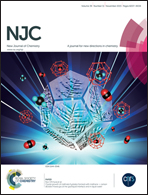Selective sensing of citrate by a supramolecular ensemble formed by a phenazine copper(i) complex and a perylene diimide derivative†
Abstract
A fluorescent sensing ensemble for citrate has been developed, which is composed of a meta-phenylboronic acid substituted dipyrido[3,2-a:2′,3′-c]-7-aza-phenazine copper(I) complex ([Cu(L1)2]) and aspartic acid modified perylene diimide (PASP). The complex [Cu(L1)2] can bind to PASP with a molar ratio of 2 : 1 ([Cu(L1)2]/PASP), and the fluorescence of PASP is efficiently quenched due to photoinduced electron transfer (PET) from PASP to [Cu(L1)2] (ΦET = 0.53). Highly selective “turn-on” type fluorescence changes are observed upon addition of citrate, with an emission enhancement (F/F0) of about 1500-fold when the concentration of citrate is 40 mM. The fluorescence enhancement shows an excellent linear relationship (R2 = 0.9972) with the concentration of citrate in the range of 25 μM to 1 mM, indicating that the PASP/[Cu(L1)2] ensemble is sensitive to citrate. In contrast, there is little change in the emission intensity of the [Cu(L1)2]/PASP ensemble upon addition of the other α-hydroxycarboxylates, dicarboxylates or monosaccharides (≤1 mM). The phenylboronic acid substituent and copper(I) ions are essential for the sensing selectivity.


 Please wait while we load your content...
Please wait while we load your content...